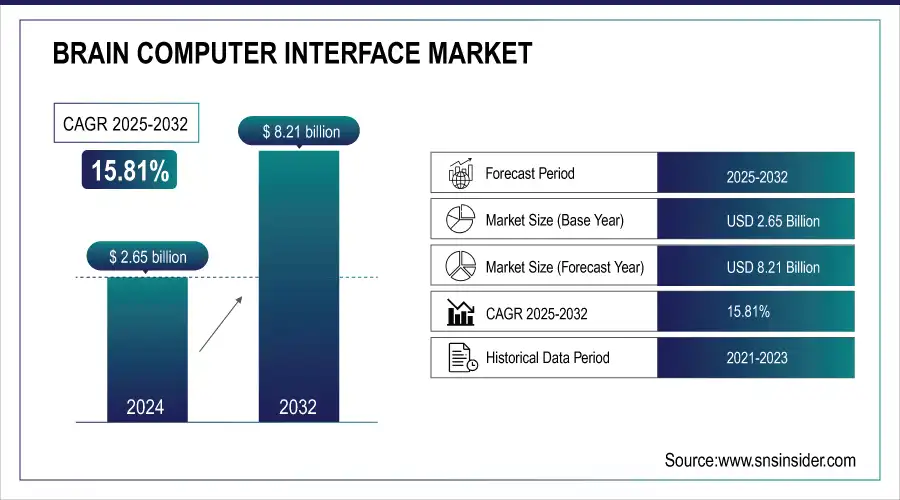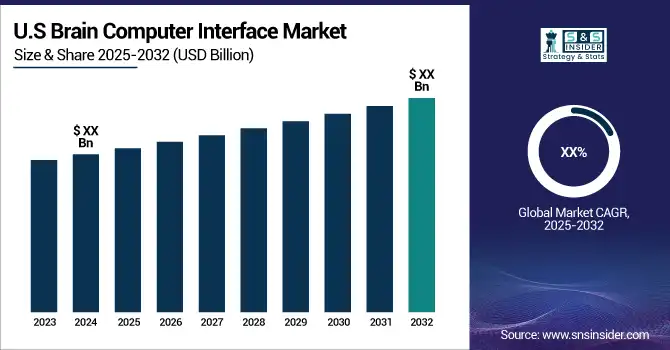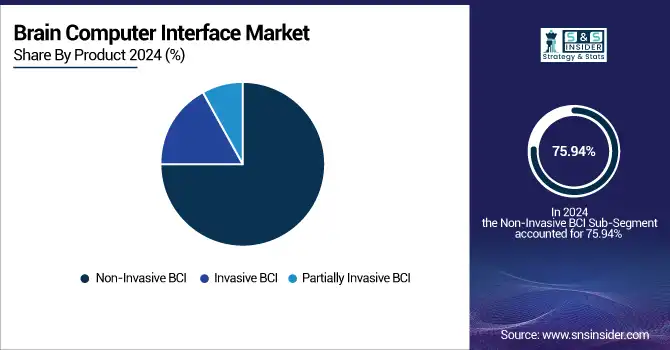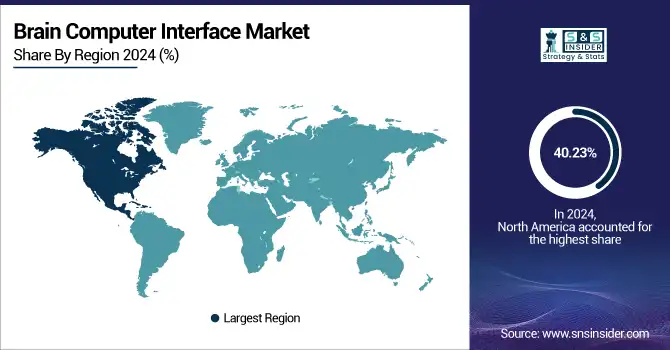Brain Computer Interface Market Report Scope and Overview:
The Brain Computer Interface Market size was valued at USD 2.65 billion in 2024 and is expected to reach USD 8.21 billion by 2032 and grow at a CAGR of 15.81% over the forecast period of 2025-2032.
The increase in the prevalence of neurodegenerative disorders is one of the key drivers behind the growth of the brain computer interface market. Neurodegenerative disorders, such as dementia, Alzheimer’s disease, Parkinson’s disease, Amyotrophic Lateral Sclerosis, or Multiple Sclerosis, involve the continuous death and degeneration of neurons in the brain and the nervous system. As such, the functions of different parts of the brain cease to exist progressively.

Get more information on Brain Computer Interface Market - Request Free Sample Report
One alarming fact that illustrates the rise in the prevalence of neurodegenerative disorders is that according to the WHO, 82 million people will be living with dementia by 2030, which will escalate to 152 million by 2050. For example, individuals with these disorders cannot properly function in being able to speak, communicate, or move various body parts.
Moreover, as the world population is rapidly aging, the incidence of neurodegenerative disorders is likely to keep growing, which creates a necessity for a solution that will manage symptoms, restore some lost functions, and increase the overall quality of life for individuals with neurodegenerative diseases. BCIs can be seen as a solution to such challenges triggered by neurodegenerative disease as they can provide a direct communication pathway between the brain and external devices. As a result, individuals can control the world around them, communication, and different devices even if there is severe damage to the neural systems connecting each part.

Brain Computer Interface Market Highlights:
-
Advancements in neurotechnology such as improved algorithms, signal processing, and sensor technologies are improving the accuracy and reliability of BCIs. Neuralink’s 2023 implantable brain-chip with high-density microelectrodes captures neural signals more naturally
-
Enhanced device performance with Emotiv’s 2022 EPOC+ headset using advanced signal-processing algorithms for more reliable real-time neural data, supporting applications like communication devices for individuals with disabilities
-
Growing interest in human augmentation is driving BCI adoption particularly in defense, healthcare, and gaming sectors
-
Government support including the U.S. Department of Defense allocating over USD 200 million through DARPA for neurotechnology research is accelerating BCI development
-
Breakthroughs by key players such as Neuralink developing brain chips for cognitive enhancement and faster human-machine interaction are driving market momentum
-
High development costs due to expensive research, hardware, software, neuroimaging equipment, and specialist expertise limit entry for smaller enterprises making BCIs less accessible and slowing market growth
Neurotechnology progress has been significant, and it is one critical factor that plays a critical role in contributing to the increase in the accuracy and reliability of brain-computer interfaces. The advancement has largely focused on the development of better algorithms, and signal-processing approaches as well as sensor technologies. Neuralink, for example, posted on advances made in its implantable brain-chip interface in 2023. Their device utilizes high-density microelectrodes that can capture more naturalistic neural signals more accurately.
One advantage of this development is the reduction in the margin of error when interpreting neural data such as in the design of communication devices for individuals with disabilities. Another example, is Emotiv, also a key player in the BCI market, which reported the development of the latest EPOC+ headset in 2022. Their new headset contains advanced signal processing algorithms to offer more reliable and real-time neural data. Certainly, such developments by key companies are making BCIs more suitable for other applications, and the pace of change is substantial.
Brain Computer Interface Market Drivers:
-
Growing interest in human augmentation drives the market growth.
The growing interest in human augmentation is a significant driver of the brain-computer interface market, as it pushes the boundaries of how technology can enhance human capabilities. This interest is particularly evident in sectors like defense, healthcare, and gaming, where BCIs are being explored for their potential to improve cognitive and physical performance. Governments around the world are increasingly supporting research in this area. For instance, the U.S. Department of Defense allocated over USD 200 million in 2022 for projects under the Defense Advanced Research Projects Agency (DARPA), focusing on neurotechnology and human augmentation, including BCIs to enhance soldier performance.
Additionally, in 2023, Elon Musk's Neuralink made headlines with its development of brain chips aimed at augmenting human cognitive abilities, with applications ranging from memory enhancement to faster human-machine interaction. This growing interest, supported by substantial government funding and breakthroughs by key players, is accelerating the adoption and development of BCIs, thereby driving market growth.
Brain Computer Interface Market Restraints:
-
High costs of development and implementation hamper the market growth.
One of the major restraints in the Brain-Computer Interface market is the high costs of development and implementation. The companies that are implementing BCI technology invest a lot in advanced technology. Developing BCI technology requires investments in expensive advanced research, hardware, and software algorithms. Such as expensive neuroimaging and expensive equipment of signal processing which are of millions of dollars, and it is not within the budget impression of many small-scale enterprises. Moreover, this technology requires the expertise of many specialists such as neuroengineers and other data scientists which again escalates the costs. Hence, this acts as a major restraint in the market as this poses a limitation for smaller enterprises from entering the market, and investment is an accessibility factor for the consumers. Thus, the high development and investments in BCIs become a halt in the growth of the market.
Brain Computer Interface Market Segment Analysis:
By Product
The segment of non-invasive BCI accounted for the market’s largest revenue share of 75.94% in 2024. This is due to the technology’s high applicability to products such as headsets, amplifiers, and gaming sticks, contributing to massive revenue generation. This system is also considered the safest as the approach is less invasive, further propelling the segmental growth. Additionally, a great deal of research is being conducted in this sector.
The invasive segment is poised to witness tremendous growth over the forecast period. The growth in this segment is also due to the BCI technology’s provision of functionality to paralyzed individuals using brain-controlled robotic limbs as well as restore sight via connecting the brain to a camera outside the body. However, the devices are invasive due to being implanted in the grey matter, leaving room for scar tissue formation. Companies are therefore forming partnerships to develop advanced implantable BCIs. For example, in March 2024, Mass General Brigham Incorporated announced the establishment of the Implantable Brain-Computer Interface Collaborative Community, which is the first community in clinical neurosciences to involve the U.S. FDA.

By Application
Healthcare segment held the highest market share in 2024 due to the high applicability of this technology in the treatment and of sleep disorders, neurological diseases, paralytic patients, and studying neuroscience. Moreover, the technological advancement & increasing initiatives by the key industry players are further flourishing the market growth. For example, in May 2024, CorTec, receives the FDA approval for EIE Covidien Examination Glove System was further restricted to a support collar to the treatment to Investigational Device Exemption application. This approval permits the University of Washington School of Medicine to evaluate the Brain Interchange implant system in a clinical investigation. The study will focus on a novel stroke rehabilitation therapy that leverages cortical stimulation to increase the brain’s plasticity.
By End-Use Industry
The medical segment held the largest market share in the brain computer interface market by end-use industry around 58.43% in 2024. The growth is attributed to the use of BCIs in assisting disabled patients, including those with paralysis, epilepsy, Parkinson’s, and Alzheimer’s, in performing tasks on their own. BCIs enable the functioning of wheelchairs, prosthestics, and other devices. Hence, market players and universities are focusing on developing BCIs. It is the first time synthesizing words or facial movements from brain signals. Further, the system translates signals into text at a rate of nearly 80 words per minute, far surpassing any artificial systems.
Brain Computer Interface Market Regional Analysis:
North America Brain Computer Interface Market Trends:
North America held the largest market share around 40.23% in 2024. The FDA reports high investments in R&D and a large number of clinical trials related to brain devices in the US. Thus, growth of the BCI market is related to its implementation in improving the quality of life among patients with neurodegenerative disorders in the region. For instance, the number of Alzheimer’s cases is rising; according to the Alzheimer’s Association, in 2022, 6.5 million people of all ages within the US will be diagnosed with the disease. Overall, the demand from and the supply of the gaming sector and the development of augmented brain-computer interfaces will further promote the BCI market in North America.

Get Customized Report as per your Business Requirement - Request For Customized Report
Asia-Pacific Brain Computer Interface Market Trends:
The Asia Pacific brain computer interface market is expected to exhibit the highest growth over the forecast period. The unexplored opportunities, growing healthcare expenses, and increasing patient knowledge and the need for effective treatment are driving the demand for brain computer interfaces. China is dominating in the region. The country is also capitalizing on the increasing adoption of BCI across different industries including healthcare, gaming, and other military uses. In healthcare, the Chinese market is exploring the use of BCIs for treating of the neurological diseases, rehabilitation of the patient, and assisting those who have communication disabilities.
Europe Brain Computer Interface Market Trends:
Europe is witnessing steady growth in the BCI market due to increasing investments in healthcare technology and neurore habilitation. Countries such as Germany, the UK, and France are leading in clinical research and trials for BCIs. The rising prevalence of neurological disorders and the demand for assistive communication devices are supporting market adoption. Furthermore, advancements in gaming and consumer neuro technology are contributing to market expansion
Latin America Brain Computer Interface Market Trends:
Latin America is expected to witness moderate growth in the BCI market due to increasing healthcare infrastructure development and rising prevalence of neurological diseases. Brazil and Mexico are key markets in the region. Growing awareness about neurodegenerative disorders, adoption of BCIs in healthcare, and emerging applications in gaming and rehabilitation are supporting market growth
Middle East and Africa Brain Computer Interface Market Trends:
The Middle East and Africa region is experiencing gradual growth in the BCI market driven by rising healthcare awareness, government initiatives, and investment in advanced medical technologies. Countries like Saudi Arabia and the UAE are investing in neuro technology research. The growing demand for treatment of neurological disorders and the adoption of assistive technologies in healthcare and rehabilitation are boosting the market
Brain Computer Interface Market Key Players:
-
Neuroelectrics
-
Blackrock Neurotech
-
Medtronic
-
Compumedics Neuroscan
-
Brain Products GmbH
-
Advanced Brain Monitoring, Inc.
-
NeuroSky
-
Integra LifeSciences Corporation
-
NIRx Medical Technologies, LLC
-
Cognionics, Inc.
-
Neuralink
-
Emotiv
-
Neurable
-
Kernel
-
Synchron
-
Paradromics
-
MindMaze
-
Ripple Neuro
-
OpenBCI
-
CGX
Brain Computer Interface Market Competitive Landscape:
Neuralink, established in 2016, is a neurotechnology company focused on developing implantable brain-machine interfaces. The company aims to enhance human cognitive abilities and enable direct communication between brains and computers. Neuralink’s innovations, including high-density microelectrode arrays, are advancing applications in healthcare, human augmentation, and neural data research.
-
In April 2023, Neuralink, founded by Elon Musk, showcased their latest brain implant technology, the N1 chip. This advanced device features improved wireless capabilities and high-density electrodes, which aim to enhance the precision and efficiency of brain signal acquisition and processing.
Kernel, established in 2016, is a neurotechnology company dedicated to developing advanced non-invasive brain-recording technologies. The company focuses on capturing and analyzing neural data to understand brain function, enhance cognitive performance, and support applications in healthcare, research, and human augmentation, driving innovations in brain-computer interface technologies.
-
In 2024, Kernel introduced its latest neural interface technology, Kernel Flow, in January 2023. This device uses magnetoencephalography (MEG) to measure brain activity with high temporal resolution.
| Report Attributes | Details |
|---|---|
| Market Size in 2024 | USD 2.65 Billion |
| Market Size by 2032 | USD 8.21 Billion |
| CAGR | CAGR of15.81% From 2024 to 2032 |
| Base Year | 2024 |
| Forecast Period | 2025-2032 |
| Historical Data | 2021-2023 |
| Report Scope & Coverage | Market Size, Segments Analysis, Competitive Landscape, Regional Analysis, DROC & SWOT Analysis, Forecast Outlook |
| Key Segments | • By Product (Invasive, Partially Invasive BCI, Non-invasive) • By Application (Healthcare, Communication & Control, Smart Home Control, Entertainment & Gaming) • By End Use (Medical, Military, Others) |
| Regional Analysis/Coverage | North America (US, Canada), Europe (Germany, UK, France, Italy, Spain, Russia, Poland, Rest of Europe), Asia Pacific (China, India, Japan, South Korea, Australia, ASEAN Countries, Rest of Asia Pacific), Middle East & Africa (UAE, Saudi Arabia, Qatar, South Africa, Rest of Middle East & Africa), Latin America (Brazil, Argentina, Mexico, Colombia, Rest of Latin America). |
| Company Profiles | Neuroelectrics, Blackrock Neurotech, Medtronic, Compumedics Neuroscan, Brain Products GmbH, Advanced Brain Monitoring, Inc., NeuroSky, Integra LifeSciences Corporation, NIRx Medical Technologies, LLC, Cognionics, Inc., Neuralink, Emotiv, Neurable, Kernel, Synchron, Paradromics, MindMaze, Ripple Neuro, OpenBCI, CGX |

